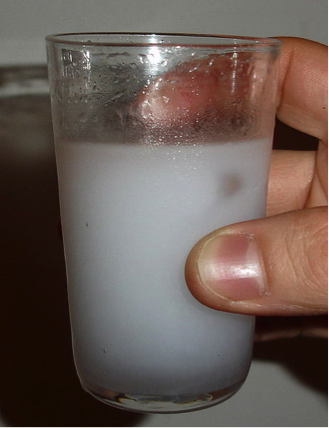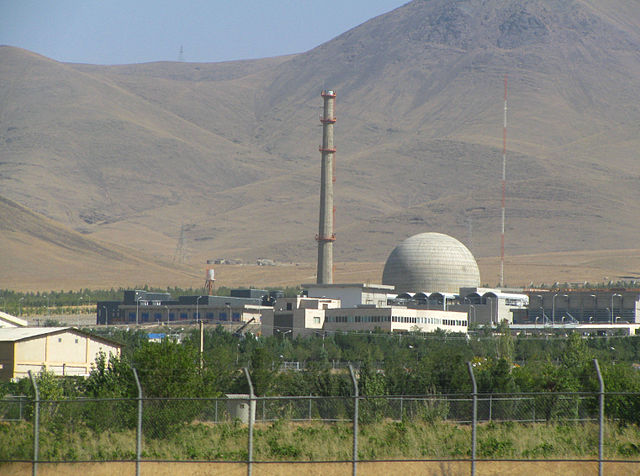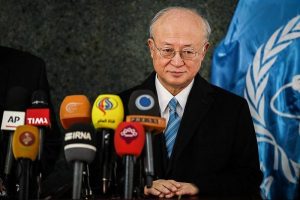by Derek Davison
Although it hasn’t been officially confirmed, Iran’s Vice-President Ali Akbar Salehi declared April 19 that Iran and the P5+1 (the US, Britain, France, China, and Russia plus Germany) had “virtually resolved” a dispute over Arak. What does this mean for the continued negotiations over Iran’s nuclear program?
 What is Arak?
What is Arak?
Arak, or araq, is an anise-flavored alcoholic beverage that is especially popular throughout the Levant. It is closely related to the Turkish beverage rak? and the Greek ouzo.
Arak and water over ice
Not that Arak.
Oh, right, the nuclear talks. Sorry.
Arak is a city of over 500,000 people, located in the Markazi province in central Iran. It’s about 150 miles southwest of Tehran. Modern Arak was incorporated in 1795 by a Georgian lord who got on Catherine the Great’s bad side and offered himself and his army to the Qajar ruler of Iran, Mohammad Khan, in exchange for sanctuary. This makes Arak almost as old as the United States of America, but for an Iranian city that’s still pretty new.
What does Arak have to do with the nuclear talks?
Iran informed the IAEA (International Atomic Energy Agency) in 2003 that it would begin construction on a “pressurized heavy water” nuclear reactor (PHWR), named IR-40 (40 because it was designed to run at 40 megawatts), at Arak. PHWRs are generally seen as greater proliferation risks than the more common “light water” reactors (LWR), so the status of the planned Arak reactor has become one of the primary issues in talks over Iran’s nuclear program.
What is a PHWR and why do they raise proliferation concerns?
A sustained nuclear reaction uses the free neutrons produced when one atom of uranium is split (fission) to strike other uranium atoms and cause them to split, but those neutrons have to be “moderated,” or slowed down, so that they will interact with fissile U-235 (the more common uranium isotope, U-238, is not fissile). Where LWRs just use regular water (H20) as coolant and neutron moderator, PHWRs use deuterium oxide (D20). Deuterium is a hydrogen isotope that contains a neutron in the nucleus (the added weight of the neutron is the reason why it’s called “heavy” water); in nature it accounts for less than 0.02% of all hydrogen in water, but the solution used in a PHWR will be nearly 100% D20.
Heavy water absorbs far fewer free neutrons from nuclear reactions than regular/light water, making it a more efficient neutron moderator. This means that it’s possible to run a PHWR using natural uranium, because all those neutrons that aren’t being absorbed are available to strike enough U-235 to sustain a reaction even in natural uranium (which contains very little U-235). LWRs require enriched uranium, which has been altered in centrifuges to artificially increase the percentage of U-235. This is the first reason why PHWRs are a proliferation concern, because while enriched uranium is subject to monitoring safeguards in how it is bought, sold, and transported on the world market, natural uranium is not. But the far greater concern is that PHWRs can produce significant amounts of plutonium as waste product, which can then be reprocessed into weapons-grade material. For example, India’s first tested nuclear weapon, Pokhran-I, was fueled by plutonium reprocessed from its heavy water CIRUS reactor, whose design is similar to IR-40’s.
Why does Iran want a heavy water reactor?
Reactors that are intended to be used for research (for example, to produce medical isotopes) rather than for power generation, often need to use uranium enriched to 20% U-235 or more, which in addition to being costly to produce is also itself a proliferation concern. PHWRs, again because D20 is such an efficient moderator, are an alternative in such applications. Iran insists that IR-40 is intended only to replace its aging Tehran Research Reactor, which produces medical isotopes for cancer patients, but the P5+1 has expressed concern about its potential use in developing a weapon. The Joint Plan of Action that was signed in Geneva in November 2014 stipulated that Iran would take no steps toward bringing Arak online for its duration.
For all the P5+1’s supposed concern about Arak, it must be noted that, as Gareth Porter has pointed out, Iran has made no move to build the kind of reprocessing facility that would be needed to convert IR-40’s plutonium waste into weapons fuel. While it could build such a facility in the future, that would take considerable time and would not be easily concealed from IAEA inspectors, so Arak is not an imminent threat from a proliferation standpoint.
What is involved in this agreement that’s been reached, and what are its implications?
To be clear, so far there is no official confirmation that any deal has been reached. But while Iranian officials have ruled out converting IR-40 to a LWR, they have suggested a willingness to modify its design. Al-Monitor’s Laura Rozen reports that the compromise is likely very similar to a proposal laid out by a group of Princeton University scientists in the journal Arms Control Today, whereby IR-40 would be modified to run on lightly enriched uranium, rather than natural uranium, and would run at a lower temperature, 10-30 megawatts rather than 40. Both of these modifications would substantially reduce the amount of plutonium waste produced by the reactor (to about the same amount as if it were converted to a LWR) without compromising its effectiveness as a research reactor.
Arak has been a prominent element in the negotiations, so if a deal over its status has been reached, then it’s likely that the negotiators are now on the last few major disputes that need to be ironed out for a comprehensive agreement. These undoubtedly revolve around the issues of uranium enrichment and IAEA monitoring, which arms control expert Robert Einhorn has argued are the biggest issues in the talks.
Photo: Iran’s IR-40 (Arak) heavy water reactor.






A deal on Arak is essential part of P5+1 final deal with Iran. Great piece.
Interesting. Sure glad I don’t live in the M.E. For all intents & purposes, besides the constant rhetoric we keep hearing about everyone wants to eliminate the Jews/Zionists, which today sounds more like the “Boy who cries wolf”. I wonder, has there been any scientific studies done concerning the health issues of the populations, especially the elderly? High blood pressure, heart attacks, strokes?